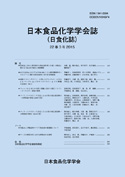Volume 11, Issue 3
Displaying 1-6 of 6 articles from this issue
- |<
- <
- 1
- >
- >|
Review
-
Article type: Article
2004 Volume 11 Issue 3 Pages 127-136
Published: December 30, 2004
Released on J-STAGE: December 01, 2017
Download PDF (1103K)
Regular articles
-
Article type: Article
2004 Volume 11 Issue 3 Pages 137-144
Published: December 30, 2004
Released on J-STAGE: December 01, 2017
Download PDF (959K) -
Article type: Article
2004 Volume 11 Issue 3 Pages 145-150
Published: December 30, 2004
Released on J-STAGE: December 01, 2017
Download PDF (663K)
Notes
-
Article type: Article
2004 Volume 11 Issue 3 Pages 151-154
Published: December 30, 2004
Released on J-STAGE: December 01, 2017
Download PDF (361K) -
Article type: Article
2004 Volume 11 Issue 3 Pages 155-157
Published: December 30, 2004
Released on J-STAGE: December 01, 2017
Download PDF (359K) -
Article type: Article
2004 Volume 11 Issue 3 Pages 158-162
Published: December 30, 2004
Released on J-STAGE: December 01, 2017
Download PDF (524K)
- |<
- <
- 1
- >
- >|
